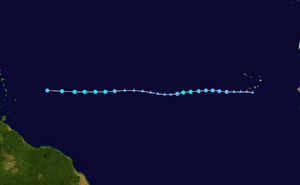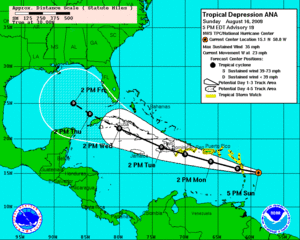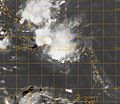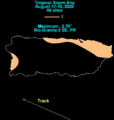Tropical Storm Ana (2009) facts for kids
| Tropical storm (SSHWS/NWS) | |

Ana as a tropical storm on August 12
|
|
| Formed | August 11, 2009 |
|---|---|
| Dissipated | August 17, 2009 |
| Highest winds | 1-minute sustained: 40 mph (65 km/h) |
| Lowest pressure | 1004 mbar (hPa); 29.65 inHg |
| Fatalities | None reported |
| Damage | Minimal |
| Areas affected | Lesser Antilles, Puerto Rico, Dominican Republic, Haiti, Cuba and The Bahamas |
| Part of the 2009 Atlantic hurricane season | |
Tropical Storm Ana was the first tropical storm of the 2009 Atlantic hurricane season. It was also the first tropical storm to hit the Caribbean in 2009. Ana started forming on August 11. However, strong wind shear (winds blowing in different directions at different heights) made it weaker by August 13.
Ana then got stronger again and became a tropical storm on August 15. But wind shear broke the storm apart once more. The storm finally ended on August 17. From August 15 to 17, the National Hurricane Center (NHC) issued tropical storm watches. These warnings were for islands like the Lesser Antilles, Puerto Rico, and the Dominican Republic. People on these islands took some steps to get ready. Most of the problems from Ana were caused by heavy rain.
Contents
How Tropical Storm Ana Formed and Moved
A tropical wave is a low-pressure area that moves through the tropics. One of these waves formed near the Cape Verde islands on August 9. The NHC started watching this wave closely. They wanted to see if it would grow into a tropical cyclone.
On August 11, the wave became a tropical depression. This means it had organized thunderstorms and a clear center. The NHC noted that the storm was almost strong enough to be a tropical storm. Even though it wasn't called a tropical storm at the time, later studies showed it did reach tropical storm strength winds.
Ana Weakens and Reforms
The next day, the storm started to lose strength. This happened because of strong wind shear and dry air. The remains of the storm then moved west across the Atlantic Ocean.
On August 14, the NHC noticed the storm was getting organized again. A special airplane called a Hurricane Hunter flew into the storm later that day. This helped the NHC track it again. On August 15, the storm was officially named Ana because it reached tropical storm strength.
Soon after, wind shear began to affect Ana once more. The next day, the storm moved into an area of dry air over the Caribbean Sea. Ana weakened back into a tropical depression. Another Hurricane Hunter airplane found no tropical storm-force winds. The storm's main circulation fell apart, and Ana completely disappeared on August 17.
Getting Ready and What Happened
On August 15, a tropical storm watch was issued for several islands. These included St. Maarten, Saba, St. Eustatius, Antigua, Barbuda, the British Virgin Islands, Montserrat, St. Kitts and Nevis, Anguilla, and the United States Virgin Islands.
Later, on August 17, Puerto Rico, Dominica, Guadeloupe, St. Martin, and St. Barthelemy were also put under a tropical storm watch. However, when Ana weakened into a remnant low (just a leftover area of low pressure) later that day, all the watches were canceled.
Impact in Puerto Rico
In St. Thomas, winds from Ana reached about 28 mph (45 km/h). Wind gusts (short bursts of strong wind) peaked at 40 mph (65 km/h).
In Puerto Rico, a lot of rain fell, causing flooding. Some streets had to be closed because of the water. About 6,000 people lost electricity. This happened when tree branches broke power lines. People also reported seeing tornadoes and waterspouts caused by Ana in Puerto Rico. The leftover parts of Ana also brought rain to parts of Hispaniola. Luckily, no damage was reported there.
Related pages
|
Tropical cyclones of the 2009 Atlantic hurricane season |
|||||||||||||||||||||||||||
|
|
||||||||||||||||||||||||||
|
|
|||||||||||||||||||||||||||
Images for kids
-
Remnants of Ana near Puerto Rico on August 17
See also
 In Spanish: Tormenta tropical Ana (2009) para niños
In Spanish: Tormenta tropical Ana (2009) para niños





